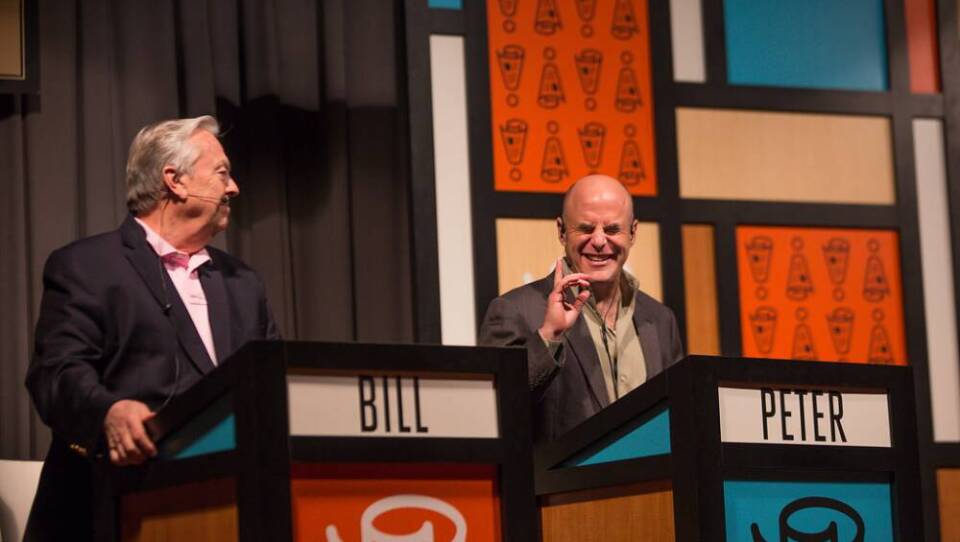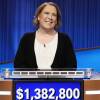Please don’t bring up the time Peter Sagal was on “Jeopardy!”
Sagal has reached a pinnacle of the quiz show game, having hosted NPR’s weekly news quiz “Wait Wait… Don’t Tell Me!” since 1998. The show is coming to Boston’s Wang Theater on Thursday.
But despite that later success, Sagal’s 1988 appearance on the iconic TV quiz show is still something he joked was “the most traumatic event of my life.”
“I graduated from a small technical college across the river from you guys,” Sagal told GBH’s Morning Edition hosts Paris Alston and Jeremy Siegel, referencing his alma mater, Harvard. “And I decided that I would head out to Hollywood, along with a dear friend of mine, to seek our fortune.”
A few months in, fame and fortune as a writer had not yet found him. So he decided to apply for “Jeopardy!”
“They scheduled me for broadcast very quickly,” he said. “Apparently, they decided that I'd be good.”
He did not practice using the buzzer, which some contestants do by clicking a pen or pressing a button as they watch from home. “That's been the secret to my success: Preparation is for other people,” he said.
Unable to hit the buzzer before his fellow contestants, he shifted to a secondary strategy: buzz in when no one else knows the answer, even when he didn’t either.
At the first commercial break, Sagal was down at negative $300. “Jeopardy!” host Alex Trebek, in his contestant interview, gave him some useful advice.
“He said, ‘You know, if you're going to do well on the show, that little thing in front of your number can't be a minus sign,’” Sagal said. He finished the game in second place, with $6,300, a reclining chair, and a television.
“Nobody knew that this whole quiz show thing was a vengeance plot of the scale of 'The Count of Monte Cristo,'” he said. “Someday, I shall be the one asking the questions.”
"Nobody knew that this whole quiz show thing was a vengeance plot of the scale of 'The Count of Monte Cristo.' Someday, I shall be the one asking the questions."
-Peter Sagal, host of NPR's "Wait Wait... Don't Tell Me!"
Next year will mark 25 years of “Wait Wait," the popular syndicated game show aired on many NPR stations.
“People ask me, who's your favorite guest? And there's so many choices,” Sagal said. “We've been doing this for so long and so many wonderful people in all walks of life, how do you choose?”
But the worst guest?
“Gene Simmons,” Sagal said. The KISS bassist and co-founder appeared on an episode in 2001.
Simmons was promoting a memoir, “which wasn’t bad, actually,” Sagal said.
“But apparently Gene Simmons, he's a very clever man. He realized that his audience for KISS and other endeavors were – I’m going to use a polite word – unpleasant people. And therefore, to appeal to those people, he needed to be as unpleasant as possible,” he said.
The segment was edited down considerably for broadcast, Sagal said.
“If you were to somehow find it, you would find the shortest guest segment in the history of ‘Wait Wait… Don't Tell Me!’” Sagal said. “He was sexist and insulting, anti-Semitic, which is odd for a person who is, himself, Jewish, and just the absolute worst.”
“Fresh Air” host Terry Gross was much more straightforward in her interview with Simmons, Sagal said.
“She just got in his face, right? She was just like, why are you so obnoxious and why do you say terrible things like that? And she was great,” Sagal said. “We, in contrast, did not broadcast any of it.”
Sagal, also a marathoner who has run the Boston Marathon as a guide for blind and visually impaired athletes, said he’ll usually run along the Charles River when he’s in Boston.
“I'm trying to think the last time I was in Boston, like actual downtown Boston or Brookline or someplace close to the Charles and didn't run the river. And I literally can't think of one right now,” he said.
But if he’s on the North Shore, he said, his favorite route is up Atlantic Avenue through Swampscott and Marblehead, over through Marblehead Neck and to the lighthouse at Chandler Hovey Park. “I arrive at the lighthouse and I pretend I'm running up the steps of the Philadelphia Art Museum,” he said. “It's one of my very favorite runs. And to get out there and to see the harbor and Salem in the distance and Beverly in the distance – it's just amazing. And then I have to run back. But that's okay.”







